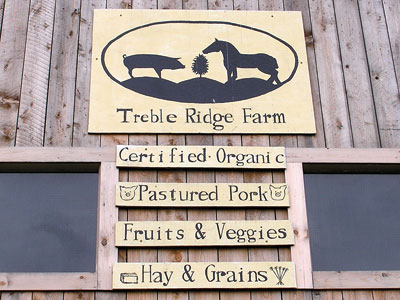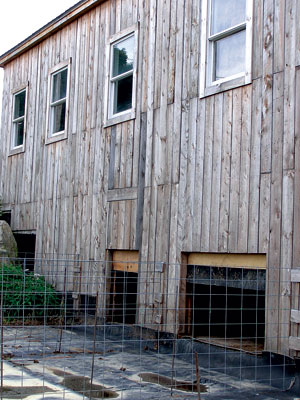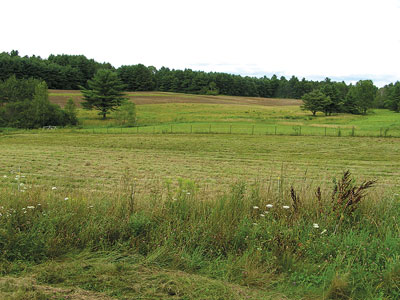 |
| Rufus Percy, with Lowell on board, treats sows to a cool shower on a hot July day. English photo. |
By Jean English
Treble Ridge Farm in Whitefield is a MOFGA-certified-organic, diversified farm – and one of an increasing number of MOFGA farms to include, in various ways, multiple generations and a supportive agricultural community.
Owners Rufus and Alice Percy grew up in the Whitefield area – Rufus on his father, Ellis Percy’s, farm in Jefferson, and Alice on her parents’ dairy goat farm in Whitefield. Alice got to know Rufus when she worked on Ellis Percy’s farm while she was in high school. After high school, she attended and graduated from Colby College, and Rufus went to the New England Culinary Institute in Vermont, interning at Primo in Rockland and then running his own catering business.
Now they and their two young sons, Calvin and Lowell, live on the farm where Alice grew up, while her parents live next door and Rufus’ family is just a town away.
The couple began farming in 2005 – originally intending to raise Icelandic sheep for meat, milk and fiber, but “we hated them,” says Alice. “They were brainless, skittish, they weren’t friendly and they got out all the time. We ate them all. They were tasty.”
Because Ellis Percy had always raised pigs, Rufus was familiar with that process. After Alice and Rufus had raised three piglets they got from Ellis, they sent two to the processor and kept one gilt. Ellis bred that pig, and Alice and Rufus bought those piglets to start their own piggery.
Now they run a five-sow farrow-to-finish pastured hog operation – the largest organic hog operation in Maine; cut hay on about 60 acres; and raise more than an acre of produce, concentrating on fruits and storage vegetables. They are also trialing grain crops, and they keep a cow and a layer flock.
Pastured Pigs
They keep a boar, Wilbur, and five sows, which are bred twice a year, so they plan to have 100 pigs per year to sell. The sows include a Yorkshire, Durok, a Berkshire cross and other genetics.
“We just select for good performance,” says Alice. “Pure breeds used commercially don’t do well on a pasture setting. Heirlooms can stay healthy on pasture but are not efficient. We’ve had the best luck with crossbreeds.”
 |
| Lowell looks in on a sow and her litter. English photos. |
 |
The sows are rotated monthly in 32- by 64-foot pens. After moving through five of these areas, 1/4 acre has been cleared.
Likewise, the feeder pigs clear another 3/4 acre each season as they are raised in smaller pig tractors – small, portable, open-bottomed structures that incorporate a three-sided shelter and an open run – and are moved weekly. The frequent moving helps prevent parasite buildup, and the smaller area encourages the smaller animals to cultivate and fertilize each patch of ground more thoroughly. The pasture where these growers are kept is nearly a quarter mile off the road, so the Percys bring two days worth of soaking grain at a time there, and keep about a week’s worth of water in a large, palletized plastic cube by the pen.
The Percys stock at high rates because the pasture is rotated with vegetable crops, following a four-year plan:
Year 1 – Pigs are on the pasture.
Year 2 – The previously pastured area is rototilled in spring, then grows a cover crop of peas, vetch and oats during the spring, summer and fall.
Year 3 – The cover crop is rototilled and the area is planted to vegetables. Thus, after pigs have been on the land, the plots are tilled twice, go through two winters, and go through 1-1/2 years before an edible crop is harvested there, far exceeding organic regulations requiring 90 or 120 days (depending on the crop) between manure applications and crop harvest. By then, any pathogens that may have been in the manure are highly likely to be gone.
Year 4 – The Percys rototill and establish a pasture crop where vegetables previously grew. The pasture grows for a year before pigs are on it.
Feeder pigs spend the winter in the basement of the Percy’s new barn, which the couple designed and then, with the help of a barn raising party, put up, using timber they’d cut from their own land.
Gestating sows winter in their summer sheds with lots of bedding or in any barn stalls that may be empty. Farrowing and lactating sows are housed in a farrowing barn year-round. “We are currently remodeling our two smaller barns so that our lactating sows can have outdoor access and the gestating sows have a dedicated winter barn,” says Alice.
 |
| The new barn at Treble Ridge, with room for feed storage upstairs and winter quarters for pigs downstairs. Rufus Percy shows the design using recycled factory belts that enables him to clean the outdoor paddocks with his tractor bucket and remove snow and ice so that the doors are easy to open year round. English photos. |
 |
 |
 |
The feeder pigs are slaughtered at Luce’s year-round, about one litter per month.
After producing three litters, the sows become less economical to keep and are slaughtered. By then, “the meat from brood sows is too gristly even for sausage in our higher-priced market,” says Alice, so they’re consumed on-farm.
Multipurpose Barn
Treble Ridge Farm’s 30- x 56-foot, red-roofed, timber-framed barn with two grain bins out front is a new landmark on East River Road. It should hold 2,000 to 3,000 bales of hay – and more.
Thanks to an ingenious system of ropes, pulleys and counter weights (recycled totes from a dairy farm), the pen doors open easily, so the pigs can access their outdoor pens.
These outdoor areas are lined with reclaimed industrial rubber belts, which Rufus buys in 370-foot rolls from Maine Industrial Pipe and Rubber in Newcastle. The rubber is better for the pigs’ feet, is easier to clean than bare ground and drains water easily. The rubber goes up and over the base of the doorway, so that snow and manure are easy to remove with a tractor bucket, and so that the doors don’t freeze shut. “We want to be able to open and close the doors every day,” says Rufus.
In 2011, the Percys will work with EQIP (Environmental Quality Incentives Program) to develop a system for moving the hogs’ bedding and manure while conserving nutrients. The sows go through 500 bales of bedding per year.
“They do donuts when we throw a new bale in,” says Rufus.
In an insulated room that will be built in the basement of the barn, the Percys will soak the grain that they’ll feed to the pigs.
Also in the basement, for vegetable storage, they’ll install a walk-in freezer and a climate controlled room, cooled with a CoolBot in summer and kept at 40 F in winter with an electric heater and humidity control.
Crop Trials
The Percys are experimenting with pasture crops. In 2010, they borrowed a drill from the Maine Grass Farmers Network to establish orchard grass and alfalfa.
At most, pasture can cut grain consumption 25 to 30 percent – “and this would be a planted pasture of high-energy crops, like oats and peas, or canola,” says Alice. “Perennial grass pastures like we use won’t cut grain consumption by more than about 10 percent. The benefits of pasture,” she adds, “are that it makes the pigs happy; it works in a vegetable rotation; and it improves the quality of the pork.
“Pasture is their salad course,” she adds. “[Pigs] can’t gain weight on pasture any more than we can on salad.”
For the pigs’ main feed, the Percys mix a whole grain ration using barley, spelt or wheat and soybeans or soybean meal. “Oats are too fibrous and too low in protein,” says Alice, “causing sows to miscarry.”
Some of the consumed grains pass through the pigs and sprout where the paddocks were, helping hold the soil while pasture crops take hold.
Piglets get leftover milk from Liberty, a Jersey cow purchased from Two Loons Farm in China, Maine, for son Calvin’s third birthday. Liberty is milked in a parlor originally designed for sheep and goats, where the 600-pound cow fits diagonally.
“If we could,” says Alice, “we would feed just small grains soaked in milk to the pigs,” but 30 pigs consume 200 pounds of grain per day, and 1 pound (1/8 gallon) of milk can be mixed with 1 pound of grain. So, “recently weaned piglets get the bulk of the milk because it does them the most good,” says Alice.
“We are making a concerted effort to buy local grain so that this is a truly local product,” she continues. “We’ve been buying feed from Aroostook County,” including spelt from James Dionne of Misty Meadows Organic Farm (mistymeadowsorganicfarm.com).
In an attempt to further localize, and to cut costs, they’re trialing grains on a couple of 1-acre plots and hope to raise all the grain they need for their animals soon.
So far, they are pleased with wheat but not with corn, “primarily because of birds and weeds” in corn, says Alice, “and we don’t particularly want to feed corn. Like soy, it makes soft fat.”
They’re also trialing fava beans, which can replace nearly all the soy in a hog ration, and which don’t have to be heat treated as soybeans do. The stiff, fibrous, 3-1/2-foot-tall fava bean stalks also contribute a lot of organic matter to the soil.
 |
| Fields ready for grain planting at Treble Ridge. English photo. |
 |
| Alice with a young plum tree. English photo. |
Small grains in general are easier and better for an operation like that at Treble Ridge: They produce more organic matter, use smaller amounts of nutrients and have fewer insect problems.
The Percys prepared about 14 acres this year to plant to small grains next year, and they were planning a trip to Pennsylvania or Ohio to buy a combine.
“If we can successfully grow our own grain, it will put us on the right side of the profit line,” says Alice.
Chicken manure and wood chips fertilize the hay and grain fields.
Varied Produce Crops
Plums grow in a design meant to promote pollination: Ten seedling-propagated pollinator trees from Fedco Trees (fedcoseeds.com/trees) are each surrounded by four American hybrids, including the varieties ‘Superior’ and ‘Toka.’ Self-pollinating ‘Green Gauge’ European plums are also in the orchard.
Several apple trees also populate the acreage, including “Kingston Black,’ ‘Wolf River,’ ‘Duchess of Oldenburg’ ‘Yellow Transparent,’ ‘Fireside’ and ‘Golden Grimes.’
Treble Ridge grows several varieties of pumpkins, including ‘New England Pie,’ ‘Howden,’ ‘Jack Be Little’ and ‘Kakai’ (for its hulless seeds). They also grow about 10 varieties of winter squash, including ‘Gill’s Golden Pippins’ and ‘Boston Marrow,’ from seed bought from Baker Creek.
Among the greens grown at Treble Ridge is sea kale, which is ready even before asparagus. A perennial, sea kale can be grown from root cuttings. The Percys plan to start an asparagus bed this coming spring.
A combination of plastic mulch, organic mulch and hand cultivation controls weeds. White-on-black plastic mulch blocks sunlight, suppressing weeds, while the upper, white layer reflects sunlight, keeping the soil cool for such crops as onions, strawberries and cabbage that prefer moderate temperatures.
The onions are transplanted from the greenhouse in groups of three or four per planting hole, to speed transplanting and reduce the number of holes in the plastic that could allow weeds to grow.
 |
| Sea kale growing at Treble Ridge. Shoots are ready before asparagus. English photo. |
Storage cabbages (both red and green) are direct-seeded through the plastic in small cardboard tubes to prevent the small seeds from washing under the plastic during rains.
The Percys plant day-neutral strawberries, which blossom and produce fruit regardless of day length, in an annual system. While traditional strawberries must be planted a year before harvest and produce for only a short time in early summer, day-neutral strawberries may be harvested the year they are planted and produce continually from late July to early October – although temperatures above 85 F reduce yields.
Ground cherries, melons and other heat-loving crops are grown on black plastic mulch. Hay mulch between the rows of plastic suppresses many weeds and helps build organic matter in the soil.
“Ground cherries,” says Alice, “are an undeservedly unusual crop. These relatives of tomatillos ripen in mid-fall. The golden-yellow berries, wrapped in a papery husk, are harvested when they fall onto the ground. Their flavor is a unique combination of melon, pineapple and citrus that makes them delicious for snacking, in fruit salads and in deserts.”
This year Treble Ridge got a SARE (Sustainable Agriculture Research and Education) grant to trial 20 open-pollinated muskmelon varieties on black plastic and under row covers supported with wire hoops.
Treble Ridge sells its products at the Common Ground Country Fair, to Morris Farm in Wiscasset, Rising Tide in Damariscotta, Fresh Off the Farm and Farmers Fare in Rockport, Rivers End Farm in Edgecomb, Five Island Farm in Georgetown, Rosemont Markets in Portland and Yarmouth, Royal River in Freeport, through Crown of Maine Organic Coop and the Whitefield Farmers’ Cooperative, and at the Camden Farmers’ Market.
Half a Decade Later
Whitefield has offered “lots of community support. I can’t imagine doing this without that,” says Alice.
That support works both ways. Treble Ridge is part of the Whitefield Farmers Guild, which will share milking equipment and labor, and will pool resources to increase farm viability, improve cash flow and meet the needs of larger markets. The guild plans to have a grocery store-style CSA, “pushing the [CSA] model beyond produce,” says Alice.
“It’s been a busy five years,” she says, surveying her family, farm and animals.
For more information, contact Alice or Rufus Percy at 207-441-2098, [email protected], 528 E. River Rd. Whitefield, ME 04353.
